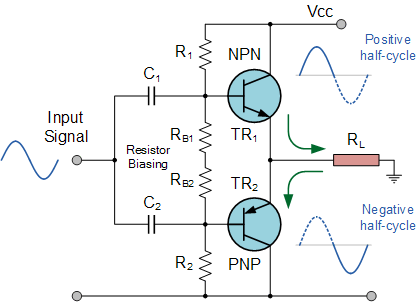 The two bluish circles labeled NPN and PNP are the transistor output devices. The squiggly lines are resistors that you can ignore. Note how the top transistor (TR1) handles what's labeled as the "positive half-cycle", the bottom transistor the "negative half-cycle".
The input signal in this illustration is a simple sine wave. The circuit breaks the sine wave apart and divides the reproduction duties between the two devices.
What you are looking at is a Class B circuit. No Class A'ness to it at all.
More tomorrow.
The two bluish circles labeled NPN and PNP are the transistor output devices. The squiggly lines are resistors that you can ignore. Note how the top transistor (TR1) handles what's labeled as the "positive half-cycle", the bottom transistor the "negative half-cycle".
The input signal in this illustration is a simple sine wave. The circuit breaks the sine wave apart and divides the reproduction duties between the two devices.
What you are looking at is a Class B circuit. No Class A'ness to it at all.
More tomorrow.
How much is enough?
by Paul McGowan
We're familiar with the common terms describing amplifier bias levels: class A, AB, and B. And we generally want more bias for better sound—which means we like class A better than the lower bias settings of AB and B. But how many of us really know what all this means? How much is enough?
Let's start at the beginning to help our understanding.
First things first. These classes of amplifiers generally apply only to solid state designs. With few exceptions, we don't worry about tube amplifiers and their output bias schemes. For simplicity sake let us just avoid the subject of tubes and agree that when we refer to the classes of an amplifier we are talking solid state.
Modern solid state power amplifiers split the output signal in two—one for the top half, the other for the bottom. Here's a picture.
 The two bluish circles labeled NPN and PNP are the transistor output devices. The squiggly lines are resistors that you can ignore. Note how the top transistor (TR1) handles what's labeled as the "positive half-cycle", the bottom transistor the "negative half-cycle".
The input signal in this illustration is a simple sine wave. The circuit breaks the sine wave apart and divides the reproduction duties between the two devices.
What you are looking at is a Class B circuit. No Class A'ness to it at all.
More tomorrow.
The two bluish circles labeled NPN and PNP are the transistor output devices. The squiggly lines are resistors that you can ignore. Note how the top transistor (TR1) handles what's labeled as the "positive half-cycle", the bottom transistor the "negative half-cycle".
The input signal in this illustration is a simple sine wave. The circuit breaks the sine wave apart and divides the reproduction duties between the two devices.
What you are looking at is a Class B circuit. No Class A'ness to it at all.
More tomorrow.
 The two bluish circles labeled NPN and PNP are the transistor output devices. The squiggly lines are resistors that you can ignore. Note how the top transistor (TR1) handles what's labeled as the "positive half-cycle", the bottom transistor the "negative half-cycle".
The input signal in this illustration is a simple sine wave. The circuit breaks the sine wave apart and divides the reproduction duties between the two devices.
What you are looking at is a Class B circuit. No Class A'ness to it at all.
More tomorrow.
The two bluish circles labeled NPN and PNP are the transistor output devices. The squiggly lines are resistors that you can ignore. Note how the top transistor (TR1) handles what's labeled as the "positive half-cycle", the bottom transistor the "negative half-cycle".
The input signal in this illustration is a simple sine wave. The circuit breaks the sine wave apart and divides the reproduction duties between the two devices.
What you are looking at is a Class B circuit. No Class A'ness to it at all.
More tomorrow.
- Choosing a selection results in a full page refresh.
- Opens in a new window.








